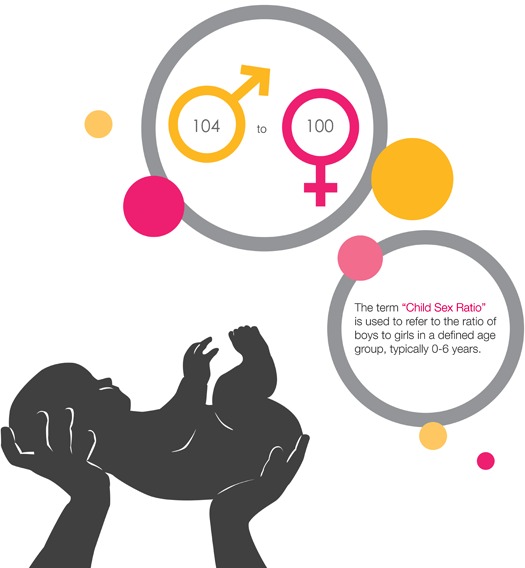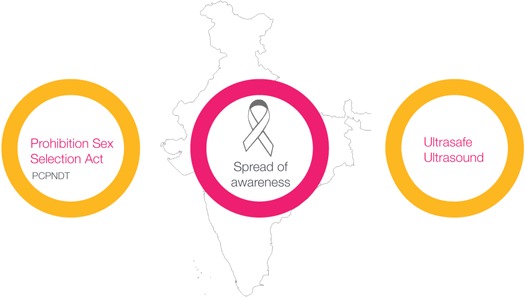
Girls are considered a burden in Indian society and over seven million have been aborted in the last decade, simply because they were girls.[1] Previous research points at social, cultural and economic factors for the gendered arrangement, but a comprehensive understanding is still missing. The problem is spreading like an epidemic and the impact is felt in various forms in different parts of India. This issue is also known as the “missing girls” phenomenon.[2]
The following infographs are my attempt at a contextual understanding of sex selection and gender imbalance in India.
Biological Gender Ratio

The biological gender ratio at birth is in favor of boys. Fewer girls are born than boys. “There are around 105 or 106 male children for every 100 female children.” [3]
India Gender Ratios

The unnatural gender ratio in India has resulted in a massive gender imbalance. In 2011, there were 940 women and 914 girls per 1000 men and boys respectively.
The imbalance is worse in urban areas, where there are 902 girls per 1000 boys. In rural India, there are 919 girls. Historically, for the last fifty years (1961-2011), the number of women in India has fluctuated between 941 and 940.[3] There were 941 women in 1961 and there are 914 women per every 1000 men today. Though the number of women or the sex ratio in India has improved since 1991, the child sex ratio or the number of children between the ages of 0-6 has been consistently declining since 1961, the fall becoming steeper since 1981. Ultrasound technology was also introduced in India in the 1980s.
International Gender Ratio

In 2011, among the ten most populous countries in the world, India had the least number of women (940) after China (926). Ten years ago, in 2001, India had the lowest number of women (933). The Russian Federation had the most number of women (1161) in 2011, followed by Japan (1055) and the United States of America (1025). [3]
Perspective

Every year 400, 000 female fetuses are aborted just because they are girls. Sex selective abortion in scholarly discourse refers to the abortion of a female fetus. “There are about 400,000 sex selective abortions per year, …With respect to the “missing girls”, the estimate is that 87 per cent of them are missing due to prenatal selection.” [4]
The number of selective abortions of female fetuses per year in India (400,000) is roughly equal to the entire estimated population of Oakland, CA (400, 740). [5]
Stakeholders

Pregnant women, family members, financially able, educated, urbanites, doctors and healthcare technicians, and easy access to sex determination technology, all are factors and major stakeholders that contribute to the imbalanced gender ratio.
Terminology

Introduced in 1960, ultrasound scan was a major breakthrough in medical imaging. Feticide is a medical procedure that constitutes a very sensitive aspect of late termination of pregnancy. In the field of reproductive technology, ultrasound scan detects foetal abnormalities. This assists doctors and patients to decide if a pregnancy needs to be terminated. [6]
However, largely in India, the combination of ultrasound — introduced in the 1980s — and feticide, has proved to be very fatal. Research, statistics and media reports show that the misuse of ultrasound technology has become a panacea for those Indians who only want boys. Such people may also choose to terminate pregnancy as soon as an ultrasound scan reveals that the fetus is a female.
This abuse of technology has given ‘feticide’ multiple meanings, some of which may be considered ‘politically charged’. [6]
Misconception

Several studies have suggested that parents are compelled to abort female fetuses because of socio-economic reasons like poverty, dowry, ignorance and illiteracy. The issue of sex selective abortions is made more complex, by equating it with the abortion debate, whereas abortion was legalized in India by the 1972 Medical Termination of Pregnancy Act. [7] “Sex selection is not about abortion, its [sic] about sex determination.” [8] “Existing feminist literature around foetal images is primarily concerned with the rights of women and the way that these are set in opposition to the rights of fetuses.” [9]
While widespread poverty and the demands for dowry in India cannot be disregarded, they are no longer the major players. The number of girls kept falling even as India became economically prosperous and literate. A McKinsey Global Institute report points to the soaring “India’s Urban Awakening”.[10] “Literacy rate has gone up from 64.83 per cent in 2001 to 74.04 per cent in 2011 showing an increase of 9.21 percentage points.” [11]
Irrespective of the reasons behind sex selective abortions in India, the truth is that the current situation of fewer girls is already affecting all sections and sectors of the Indian society and beyond.
Consequences

What will the future look like if the number of girls in India continues to decline?
Christophe Z Gilmito in “Characteristics of Sex-Ratio Imbalance in India and Future Scenarios,” points to demographic and other changes: “fewer women today translates into fewer births after 20 years”. There will be 47 million more men than women by 2050. [12] Female deficit for marriage is already witnessed in some parts of the country. Rise and increase in social problems and gender violence is on the rise. The December 2012 Delhi gang rape is a testimony. Scholars project major changes in family structures and a demographic disequilibrium that will be felt beyond the Indian borders.
Changes

Several steps have been taken to address and correct the issue of sex selective abortion of female fetuses in India. “In order to prohibit sex selection and prevent misuse of technology for preconception and prenatal sex determination, the Government of India enacted the Pre-conception and Pre-natal Diagnostics Techniques (Prohibition of Sex Selection) Act, 1994 (PCPNDTAct).” [13] PCPNDT was amended in 2003. Efforts by the government, NGOs, activists, researchers and awareness campaigns are ongoing. The project, Ultrasafe Ultrasound, uses a “novel ultrasound technology” that “… strives to curb female feticide in developing nations by automatically blurring the genitalia of the fetus in live images produced by ultrasound machines.” [14] ‘Ultrasafe Ultrasound’ is also a semifinalist in the Dell Social Innovation Prize 2013.
Understanding

In order to better understand the issue of sex selective abortion of female fetuses in India, more reliable data, especially at the regional levels in India is needed (UNFPA). There is an urgent need to “prioritize sex selection” now. [12]
Notes
The author would like to acknowledge the support from a SEAD grant by The Institute for Creativity, Arts, and Technology at Virginia Tech. Michelle Gailhac’s (mg2@vt.edu) graphic design contribution is very instrumental to this essay. I also thank Hannah Tushara for technical assistance.
1. Prabhat Jha et. all http://cghr.org/wordpress/wp-content/uploads/Trends-in-selective-abortions-of-girls-in-India-2011.pdf
2. Amartya Sen, “More Than 100 Million Women are Missing, The New York Review of Books”
3. Provisional Population Totals Paper 1 of 2011 India, Series 1; Chapter 5
4. Report of the International Workshop on Skewed Sex Ratios at Birth: Addressing the Issue and the Way Forward
5. United States Census Bureau
6. Ruth H. Graham, Stephen C. Robson, Judith M. Rankin, “Understanding feticide: An analytic review” in Social Science and Medicine 66 (2008) 289–300
7. N.L. Pandey, O.P. Gupta Legalization of Abortion in India, US National Library of Medicine, National Institutes of Health
8. Anuradha Vemuri, UNFPA, Presentations made by Resource Persons at the PNDT Workshop
9. Julie Palmer, “Seeing and knowing: Ultrasound images in the contemporary abortion debate”, Feminist Theory, July 8, 2009
10. http://www.mckinsey.com/insights/urbanization/urban_awakening_in_india
11. Census of India: Provisional Population Totals 2011: India: Census 2011
12. Christophe Z Guilmono, UNFPA, “Characteristics of Sex-Ratio Imbalance in India and Future Scenarios,” 4th Asia Pacific Conference on Reproductive and Sexual Health and Rights
13. UNFPA India, Reports. (2012) “Towards a Stronger Implementation of the Pre-Conception and Pre-Natal Diagnostic Techniques (PCPNDT) Act”
14. Ultrasafe Ultrasound
The author would like to acknowledge the support from a SEAD grant by The Institute for Creativity, Arts, and Technology at Virginia Tech. Michelle Gailhac’s (mg2@vt.edu) graphic design contribution is very instrumental to this essay. I also thank Hannah Tushara for technical assistance.
1. Prabhat Jha et. all http://cghr.org/wordpress/wp-content/uploads/Trends-in-selective-abortions-of-girls-in-India-2011.pdf
2. Amartya Sen, “More Than 100 Million Women are Missing, The New York Review of Books”
3. Provisional Population Totals Paper 1 of 2011 India, Series 1; Chapter 5
4. Report of the International Workshop on Skewed Sex Ratios at Birth: Addressing the Issue and the Way Forward
5. United States Census Bureau
6. Ruth H. Graham, Stephen C. Robson, Judith M. Rankin, “Understanding feticide: An analytic review” in Social Science and Medicine 66 (2008) 289–300
7. N.L. Pandey, O.P. Gupta Legalization of Abortion in India, US National Library of Medicine, National Institutes of Health
8. Anuradha Vemuri, UNFPA, Presentations made by Resource Persons at the PNDT Workshop
9. Julie Palmer, “Seeing and knowing: Ultrasound images in the contemporary abortion debate”, Feminist Theory, July 8, 2009
10. http://www.mckinsey.com/insights/urbanization/urban_awakening_in_india
11. Census of India: Provisional Population Totals 2011: India: Census 2011
12. Christophe Z Guilmono, UNFPA, “Characteristics of Sex-Ratio Imbalance in India and Future Scenarios,” 4th Asia Pacific Conference on Reproductive and Sexual Health and Rights
13. UNFPA India, Reports. (2012) “Towards a Stronger Implementation of the Pre-Conception and Pre-Natal Diagnostic Techniques (PCPNDT) Act”
14. Ultrasafe Ultrasound
